Adrian Collins's Blog, page 165
August 18, 2021
REVIEW: This Thing Between Us by Gus Moreno
Not always does a book perfectly embody a fixed emotion, especially one as complicated as grief. Gus Moreno’s latest novel This Thing Between Us depicts loss with such rawness and genuinity, it emits off the page.
 This Thing Between Us begins with Thiago Alvarez mourning the tragic death of his wife Vera. His narrative written as his own intimate monologue to her. As newspapers and politicians begin to sensationalize the horrible circumstances of her passing, Thiago becomes recluse. He knows there was an unexplainable reason behind Vera’s death, something unknown to reporters. The evidence overwhelming proves something awoke inside the home Thiago and Vera had recently bought. It wasn’t just the curious banging noises and scratching on the walls. It wasn’t just Itza, their smart speaker that sang and performed light shows at odd intervals. Vera’s death was only the beginning. Something is haunting Thiago.
This Thing Between Us begins with Thiago Alvarez mourning the tragic death of his wife Vera. His narrative written as his own intimate monologue to her. As newspapers and politicians begin to sensationalize the horrible circumstances of her passing, Thiago becomes recluse. He knows there was an unexplainable reason behind Vera’s death, something unknown to reporters. The evidence overwhelming proves something awoke inside the home Thiago and Vera had recently bought. It wasn’t just the curious banging noises and scratching on the walls. It wasn’t just Itza, their smart speaker that sang and performed light shows at odd intervals. Vera’s death was only the beginning. Something is haunting Thiago.
With the apparent ending being Vera’s death, I didn’t expect This Thing Between Us to contain many surprises. Based on the blurb, my thoughts immediate jumped to 2001: A Space Odyssey and Her. This book isn’t even shy about referencing titles it could be categorized with. My assumptions left me wildly unprepared for this unsettling and harrowing novel. With enthralling characterization and frightening new horrors, This Thing Between Us thrives entirely on its own.
Thiago is a captivating main character. His sorrow catching. While Thiago is struggling to make sense of his wife’s death, his mother-in-law embraces him with contempt. The Alvarez family has a dark history. His surname considered ill dispute within society, Thiago is not so accepted within his family either. Despite his appearance, he was never Mexican enough; deemed a “wannabe white person” by others. Thiago’s specific narrative is an overlooked but authentic account of finding one’s place in America.
This Thing Between Us emphasizes more on psychological horror than solving mystery. I felt ensnared between Thiago’s grief and this unsettling supernatural presence. Gus Moreno almost teases this evil manifestation. It’s chaotic nature making it difficult to fully comprehend its full power and magnitude. I wish more had been revealed about its nature. By keeping the story focused on Thiago, we are made witnesses to his ordeal and limited by his understanding.
This Thing Between Us is a book I won’t easily forget. Influenced by his own grief, Gus Moreno channeled such painful emotions and transformed them into a breathtaking story. He is an author to follow.
Read This Thing Between Us by Gus Moreno
The post REVIEW: This Thing Between Us by Gus Moreno appeared first on Grimdark Magazine.
August 17, 2021
An Interview with Anna Mocikat
I am pleased to say that we have another author interview with indie cyberpunk maven, Anna M0cikat. The author of Behind Blue Eyes and its sequel is here to talk about her recent work!
 GdM: What can you tell us about Behind Blue Eyes?
GdM: What can you tell us about Behind Blue Eyes?
Behind Blue Eyes is a cyberpunk book series, currently consisting of two books with the third scheduled for March 2022. It’s a dark, action-driven story about a killer cyborg who realizes that everything she has been fed her entire life was a lie and decides to take a stand against the system and her creators.
GdM: Tell us about your protagonist, Nephilim.
Nephilim is an elite soldier, the perfect human-machine hybrid, and part of a killer squad called Guardian Angels. They have been created to keep Olympias safe from enemies from outside and within. From early childhood, Nephilim has been indoctrinated into believing Olympias was the perfect society and that she was fighting a righteous cause – which, of course, is a lie. After a glitch that separates her from the grid, she begins thinking for herself which ultimately leads to her rebellion. Nephilim isn’t a young girl looking for her destiny, she’s a badass killer, a weapon. Yet she’s also so much more than that.
GdM: What draws you to cyberpunk? Why choose to write in this genre?
I’ve been in love with Cyberpunk since I saw Ghost in the Shell in the late 90s for the first time. To this day it’s my favorite movie and I had the iconic poster with the nude Major Motoko with all the wires sticking out of her hanging in my bedroom for many years… somehow, I lost it during my last move, and I think it’s about time to get a new one, haha. Ever since I wanted to write a cyberpunk novel myself and I had the idea to Behind Blue Eyes for many years but somehow got distracted by other projects. Now that I finally started writing in the genre, I don’t think I will ever let go of it again.
GdM: What sort of place is Olympias City?
Olympias is a dystopia coming disguised as a utopia. It claims to be the perfect place of happiness, the best society in human history. They claim they’ve gotten rid of everything that had made human life miserable in earlier times. There’s only one catch. People who don’t want to participate in the perfect lifestyle are mercilessly hunted down and killed. Olympias doesn’t tolerate anything other than their philosophies.
GdM: What sort of themes do you explore in this book?
I think the most important theme in Behind Blue Eyes is freedom. Freedom of choice, freedom of speech, freedom of thought. It’s something the citizens of Olympias don’t have. And in my opinion, those are values that are worth being defended at any cost.
Another important theme is the human vs. machine one. In a future of almost limitless augmentations, where does the human end and the machine start? It’s also about the dark sides of technology.
GdM: Could you describe the antagonist of your book?
It will be my pleasure! The antagonist in Behind Blue Eyes is called Metatron. For a reason which is explained in the book, all cyborgs wear angel names. Metatron is the leader of the Guardian Angels; the elite cyborgs Nephilim is a member of. He’s absolutely ruthless and sadistic but he’s also highly intelligent, educated, and sophisticated. And he’s obsessed with Nephilim – for a reason that I can’t mention as it would be a massive spoiler.
I love multi-layered villains of great depth. The ones who constantly walk the thin line between being monsters and righteous. Metatron is my masterpiece (and I have been a professional writer for more than 20 years). Although clearly the villain, he’s still very likable, so much, that he’s the second most popular character in the book among readers. I think he tickles the hidden desire everyone has to submit to the dark side. And there’s so much more to him than it seems!
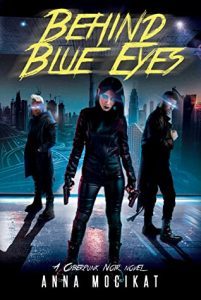 GdM: Who would you cite as your influences?
GdM: Who would you cite as your influences?
As mentioned before, my biggest influence is clearly Ghost in the Shell. In a way, Nephilim is like the dark, twisted little sister of Motoko. I see my work more in the tradition of the Japanese cyberpunk with Ghost in the Shell, Akira, Appleseed, or Ergo Proxy, whereas most contemporary cyberpunk authors cite Gibson as their greatest influence.
I also love the works of Philip K. Dick, Isaac Asimov, George Orwell and Aldous Huxley. BBE has themes from both 1984 and Brave New World in it, which are two of my all-time favorite books.
GdM: How do you like being an independent author?
Very much. I used to be traditionally published and had a big publisher back in Germany, where I published my first books. Here in the US, I was with a small publisher at first and am now full indie. The problem with publishers is, that in the end, the people who work there are just employees. They will go home at five and will never care as much about your book as you do. When they screw something up (and publishers screw up stuff all the time!), there’s nothing you can do about it. As an indie, I have full control. If someone screws up something, it’s me. And I will rather work for 18 hours every day for weeks to make things perfect than leave anything to chance. I’m a perfectionist.
GdM: How has the reception for Behind Blue Eyes been?
Extremely positive! Most people absolutely love the book. When I first published it last year, I was surprised how much people love it. Usually, there will always be people who won’t like your work and I had that with all my other books, but not with Behind Blue Eyes. People write me emails, telling me how much they loved it, others write poems inspired by Nephilim or create fan art of her. I also know several people who have developed a serious crush on her haha
All of this means very much to me as I believe Behind Blue Eyes is my best work and it has a very special place in my heart. I couldn’t be happier about the positive response.
The interesting thing about this is that once people read the book, most will love it. However, it’s very difficult to convince them to do so. I’m one of the very few female cyberpunk authors, and even fewer who don’t hide their identity behind gender-neutral pen names. Readers have prejudices against female sci-fi authors and cyberpunk in particular. They don’t expect my book to be really gritty, dark and action-driven (which it is 100%!) because so many women in the genre write YA or romance.
I feel I have to convince every single reader to give me a chance and once they do many will tell me, they have seen the book on Amazon or social media before and wish they would have picked it up much earlier.
GdM: What can you tell us about the sequel?
Behind Blue Eyes is only the first chapter in a much bigger and very complex story. I even see it more as a prologue than a chapter. It sets the stage for everything else that is going to happen. Many readers were surprised about the ending of book 1 and didn’t see some of the revelations coming at all. The way the story proceeds and where it is going will be even more surprising.
In book 2 someone is making hunt on the seemingly invincible Guardian Angels and is murdering them one by one. Nephilim is put in charge of the investigation, and it will lead her not only in Olympias’ darkest underbelly but also into the shiny world of the elites in the Inner Circle.
The second book has even more of a noir feel but as much action, violence, and sex as the first book – as you see, no YA themes here.
Read Behind Blue Eyes by Anna Mocikat
The post An Interview with Anna Mocikat appeared first on Grimdark Magazine.
August 16, 2021
REVIEW: Mindfracked by M.R. Forbes
Mindfracked by M.R. Forbes is another fantastic indie cyberpunk novel that I am pleased to share with our audience. I was a huge fan of the Altered Carbon Netflix series as well as the original book trilogy by Richard K. Morgan. However, I felt the subject of bodyswapping was something that could have used a bit more attention. I also admit to wishing we’d seen more of Takashi Kovacs as an Envoy for the U.N. than as a freelance merc. While having his own spin on the subject, M.R. Forbes delves deeply into science fiction thriller territory.
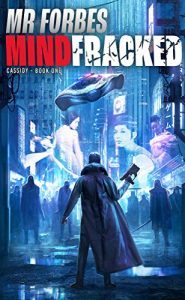 The premise is that there is an organization in the future called UNITY that employs specialized mercenaries called Shades. Shades are AI scans of human brains that are uploaded into new bodies in order to possess them. They serve fifty missions and then are released back into their original cryogenically frozen body. Theoretically. Cassidy is on his 48th mission at the start of the book and soon on his 49th with hopes of retirement. Unfortunately, things are clearly a lot more complicated than they thought.
The premise is that there is an organization in the future called UNITY that employs specialized mercenaries called Shades. Shades are AI scans of human brains that are uploaded into new bodies in order to possess them. They serve fifty missions and then are released back into their original cryogenically frozen body. Theoretically. Cassidy is on his 48th mission at the start of the book and soon on his 49th with hopes of retirement. Unfortunately, things are clearly a lot more complicated than they thought.
Cassidy is an interesting character that I very much enjoyed getting into the headspace of. He’s a ruthless and pragmatic man without much loyalty to his employers. He believes they’re the lesser evil but he’s here because the government provides a steady paycheck to his family. A family that he hasn’t seen in decades because of the fact that he doesn’t have a civilian life between missions.
Mindfracked is a dark and edgy thriller as Cassidy goes from body to body, struggling to figure out the various angles being played around him. The book has a very high body-count and benefits from the fact people you would normally think would be safe are killed regularly. I like this as it helps establish the grim and gritty nature of the world. This is a dark, hard, R-rated cyberpunk and that is just the way I like it.
The world is a dark one where the technology of humanity has evolved greatly but the human race is in even more dire straights than it was in our century. The environment has completely collapsed, poverty is everywhere, and human life is exceptionally cheap. It also doesn’t take much to note that the Shades are the enforcement arm of an extremely corrupt fascist state. In short, it is is properly dystopian and if you like that sort of thing than this is the book for you.
The book does have one flaw and that’s attempting to paint one group at the start of the story as misunderstood heroes rather than monstrous villains. This falls flat and doesn’t make any sense since they start with several atrocities and proceed to run over the moral event horizon from there. This is a small flaw in an otherwise excellent book, though.
This is a solid and entertaining indie novel that I think fans of the genre should pick up. It’s available on Kindle Unlimited so the price is right as well. I will state that I recommend those who like audiobooks to pick up the Jeffrey Kafer version. It’s an absolute blast and his voice acting really adds to the experience.
Read Mindfracked by M.R. Forbes
The post REVIEW: Mindfracked by M.R. Forbes appeared first on Grimdark Magazine.
August 14, 2021
REVIEW: Nolyn by Michael J. Sullivan
Bestselling author Michael J. Sullivan has just released the first book in his new trilogy, The Rise and Fall. Nolyn is set in the same world as Sullivan’s beloved Riyria novels and The Legends of the First Empire series. This novel takes place about 850 years after the end of the Legends series and 1000 years before Riyria. The Rise and Fall series will depict the formation and collapse of an empire over time, with each novel following a different main protagonist. Grimdark Magazine received an ARC of Nolyn in exchange for an honest review. This review contains minor spoilers for The Legends of the First Empire.
“When the fate of the world is in your hands, gambling is an unaffordable luxury, and idealism is often burned on the altar of reality.”
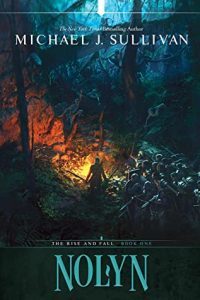 Though Sullivan states it is not necessary to read any of his other novels before Nolyn, a knowledge of the history of the empire and its power struggles adds vital context. With a dozen and counting published books set in the world, new readers may feel intimidated. Readers who know little of the world of Elan may be puzzled by repeated references to the Legends of the First Empire series. Reading Sullivan’s books in publication order offers the most gratifying reading experience.
Though Sullivan states it is not necessary to read any of his other novels before Nolyn, a knowledge of the history of the empire and its power struggles adds vital context. With a dozen and counting published books set in the world, new readers may feel intimidated. Readers who know little of the world of Elan may be puzzled by repeated references to the Legends of the First Empire series. Reading Sullivan’s books in publication order offers the most gratifying reading experience.
The plot follows Nolyn—the only son of human Persephone and elf Nyphron —in the tumultuous events leading to Nolyn’s ascension from heir to emperor. Nolyn, who has lived for centuries at odds with his militaristic father, has just been ordered to the front lines of the Goblin Wars in an assignment that is essentially a death sentence. Meanwhile, Nolyn’s childhood friend and love interest Sephyryn has been unsuccessfully trying to improve the lives of humans in the Empire for generations. The series of events that unfold following the kidnap of Sephyryn’s child near the beginning of the novel could have implications that derail the empire’s progress forever.
“Everyone has to pay, but heroes—I think they have a higher price than everyone else. And maybe they never erase their debts.”
A thought-provoking recurring theme in Sullivan’s novels is how myths and stories are born and manipulated, affecting civilizations for generations. Because many of Sullivan’s characters are long-lived, they witness firsthand how history can be blurred by bias, myth, and memory. Readers witness how Nolyn’s father, Emperor Nyphron, has molded history and myth to shape his elf-first vision of the empire. The Riyria novels set hundreds of years later display a future when even Nyphron’s story has been rewritten into something unrecognizable.
Nolyn will inevitably draw comparisons to Sullivan’s previous works. While it does live up to the magic of Riyria in its third act, Nolyn differs significantly in subject matter and tone. While the Riyria series is an adventure tale following odd couple ex-mercenary Hadrian Blackwater and cynical thief Royce Melborn, The Rise and Fall series is shaping up to be more of a mythological fantasy depicting fictional historical events. The plot arc and character dynamics of Riyria are more fun and leave space for surprise and humor interspersed with stylish splashes of violence. Royce and Hadrian are so engaging and well-rounded that by comparison, Nolyn and Sephyryn can sometimes feel hollow with their predictable choices and lack of meaningful interaction with each other.
Sephyryn’s plotline in particular contains little of the levity or character development that readers may have come to expect from Sullivan’s novels. Her point-of-view in the novel feels disappointingly inconsequential; she is given little agency or moments of growth and primarily serves as an absent love interest and catalyst for the male character’s rise to power. Over the course of the novel, Sephyrn is compelled, in gallingly predictable ways, into awful situations while failing to consider any path other than the one set in front of her.
This might have worked with the right foil, but unfortunately, the morally ambiguous types of characters depicted in many of Sullivan’s previous works are more or less absent in Nolyn. Readers may question why there are no interesting new villains or anti-heroes to accompany this new series. The bad guys as depicted in Nolyn are generally unsubtle stereotypes: kidnapping children, murder of innocents, and machinations to rule the world are all in the playbook.
Sullivan’s writing truly shines in moments when characters who know each other well are allowed to banter and interact with each other. Nolyn’s perspective chapters, in which he joins and travels with a squadron of skilled warriors as he attempts to stay alive, are among the most engaging scenes in the book. The cast of compelling side characters, especially Nolyn’s band of brothers, elevates the book any time they show up—though one wishes they were explored more deeply, with fully fleshed-out backstories and independent motives.
Like Brandon Sanderson, Sullivan is an extremely organized and prolific writer. Sullivan has a process in which he writes a series first and then publishes each book about a year apart. This technique allows the author a lot of precision in plotting and editing to maximize effective storytelling and continuity. Fans of Sullivan’s previous works may find themselves consulting the Riyria Wiki to help identify easter eggs and continuing threads.
With a slew of successful Kickstarter campaigns to fund his novels, Sullivan has a devoted and supportive fanbase that will definitely enjoy this newest novel. Readers who enjoy the cycles of history and myth in Robert Jordan’s Wheel of Time series should definitely check out Sullivan’s work.
In Nolyn, Sullivan has penned an enjoyable tale with consistent prose and meticulous attention to detail. Though the novel perhaps does not match the charm and rereadability of its predecessors, it is definitely worth picking up. Entertaining and immersive, Nolyn is a great summer read for fans of epic fantasy.
3.5 stars
Read Nolyn by Michael J. Sullivan
The post REVIEW: Nolyn by Michael J. Sullivan appeared first on Grimdark Magazine.
August 13, 2021
So, you want to become an SFF book reviewer?
Book reviewing in the SFF community is an awesome gig. The books hitting our inboxes and post boxes in 2020 and 2021 just keep getting better and better. And as an SFF book reviewer, one of the major bonuses of the gig is getting access to these books months in advance–added bonus if you’re in the UK because those print hardcover advanced reader copies (ARCs) are fucking gorgeous.
Then, all you need is the time you spend reading the books anyway, an opinion on them, and to be able to put that opinion into a coherent 400+ word post.
So, assuming at this point you’re pretty keen on getting a glimpse into the world of reviewers, I asked our brilliant GdM team about what they focussed on when writing reviews.
Carrie Chi Lough My friend’s passion for reviews influenced me to start writing them. Immediately, I noticed a difference. In writing a review, I take everything I felt about a book and turn them into concise words. I’ve noticed plenty of times, my thoughts about a book change once I sit down to write. It’s about gaining a deeper appreciation and understanding about what I’ve read. It’s hoping someone will read my review and become hyped to read the book themselves. Anymore, I don’t consider a book finished until after the review is written.
My friend’s passion for reviews influenced me to start writing them. Immediately, I noticed a difference. In writing a review, I take everything I felt about a book and turn them into concise words. I’ve noticed plenty of times, my thoughts about a book change once I sit down to write. It’s about gaining a deeper appreciation and understanding about what I’ve read. It’s hoping someone will read my review and become hyped to read the book themselves. Anymore, I don’t consider a book finished until after the review is written.
 The key aspects for me are communicating how the book made me feel in a way that instantly makes a reader feel that they may connect with the story. It may be characters that are unique but relatable, plot lines that keep me up all night and force me to turn the next page, or settings that feel vivid and real. Writing reviews allows me to take my time when digesting what I’ve read and hopefully brings a larger audience to authors who deserve it thanks to their hard work and wonderful writing!
The key aspects for me are communicating how the book made me feel in a way that instantly makes a reader feel that they may connect with the story. It may be characters that are unique but relatable, plot lines that keep me up all night and force me to turn the next page, or settings that feel vivid and real. Writing reviews allows me to take my time when digesting what I’ve read and hopefully brings a larger audience to authors who deserve it thanks to their hard work and wonderful writing!
 The first thing I tend to think of when reviewing is context. This is the book, the author, the date of publication, the place of the work within any series or franchise or genre landscape. “Here, dear reader, are the things you need to best approach this novel.”
The first thing I tend to think of when reviewing is context. This is the book, the author, the date of publication, the place of the work within any series or franchise or genre landscape. “Here, dear reader, are the things you need to best approach this novel.”
After that, the focus is on establishing other details – an indication as to the plot, elements of technique (the latter I could probably work better on). Suitable comparisons to other works may appear in this portion.
With those foundations in place, I can talk about my feelings on the book with a touch of ‘authority’ – scare quotes to indicate that I do not possess a PhD in Grimdark Studies. These are always going to be the least coherent – and possibly, the least relevant – parts of a review for the reader and I am hardly certain that my discernment in these matters is so very advanced. This isn’t to say that I count this portion of the review as unimportant, but I do try to be modest or precise in the claims I make as part of it. Qualified rapture, as they say.
Fabienne Schwizer For me, the key thing about reviewing is how a book makes me feel. All the great writing and characters in the world aren’t enough if the story doesn’t emotionally connect to the reader. I usually try to write a few sentences of copy about the main themes of the book to get the reader stuck into the review and hopefully get invested. Then I talk about the main aspects I liked (or, perhaps, didn’t like) and explain why, so that they can make an informed decision whether this might be one for them. I like ending on a catchy statement or recommendation.
For me, the key thing about reviewing is how a book makes me feel. All the great writing and characters in the world aren’t enough if the story doesn’t emotionally connect to the reader. I usually try to write a few sentences of copy about the main themes of the book to get the reader stuck into the review and hopefully get invested. Then I talk about the main aspects I liked (or, perhaps, didn’t like) and explain why, so that they can make an informed decision whether this might be one for them. I like ending on a catchy statement or recommendation.
 For me, what I look for in a book is how it made me feel. What is my overall perception of the book? Did it make me happy or sad? Do I want to know more? I try to convey that to whoever reads the review to decide if the book is for them. I love reading, and even more so, I love sharing that love with people. Through the reading community, I have discovered so many great books, particularly self-published ones.
For me, what I look for in a book is how it made me feel. What is my overall perception of the book? Did it make me happy or sad? Do I want to know more? I try to convey that to whoever reads the review to decide if the book is for them. I love reading, and even more so, I love sharing that love with people. Through the reading community, I have discovered so many great books, particularly self-published ones.
 One of the key things about reviewing for me is getting people excited to read what you’re reading–to share the experience with me. To pass on that excitement (or at times, disappointment) requires the ability to translate passion for reading into your review writer’s voice.
One of the key things about reviewing for me is getting people excited to read what you’re reading–to share the experience with me. To pass on that excitement (or at times, disappointment) requires the ability to translate passion for reading into your review writer’s voice.
From a more technical side–when I’m putting in the team’s reviews–I enjoy ensuring the SEO is solid to give the post and the reviewer’s work the best chance of being seen by as many viewers as possible.
James Tivendale I tend to find reviewing SFF books rewarding and sometimes challenging and I try to review novels early if I can. I don’t read blurbs or other reviews before writing my own so I turn my indecipherable scribble notes into the reviews you can find on this blog, knowing that every word is my honest, uninfluenced thoughts. I proofread my reviews about 17 times, and occasionally get Beth Tabler to check them too. Once I’ve posted my review, I then see what reviewers I respect have said about the same book in their reviews, to see whether we agree or disagree. Only then do I class the book experience as finished and move on to the next one!
I tend to find reviewing SFF books rewarding and sometimes challenging and I try to review novels early if I can. I don’t read blurbs or other reviews before writing my own so I turn my indecipherable scribble notes into the reviews you can find on this blog, knowing that every word is my honest, uninfluenced thoughts. I proofread my reviews about 17 times, and occasionally get Beth Tabler to check them too. Once I’ve posted my review, I then see what reviewers I respect have said about the same book in their reviews, to see whether we agree or disagree. Only then do I class the book experience as finished and move on to the next one!
 I usually kick off with my personal impression of an author or the subject they’re delving into, followed by a brief description of their work and my impressions based on story, setting, originality, risks taken & use of language. I conclude the review with a para on whether or not I think the work has achieved its goal and also assign it a rating. I like to review creative work firstly because I like writing, secondly to introduce readers to a story I think is worth sharing, or thirdly to champion the work of creatives who I don’t think get enough recognition.
I usually kick off with my personal impression of an author or the subject they’re delving into, followed by a brief description of their work and my impressions based on story, setting, originality, risks taken & use of language. I conclude the review with a para on whether or not I think the work has achieved its goal and also assign it a rating. I like to review creative work firstly because I like writing, secondly to introduce readers to a story I think is worth sharing, or thirdly to champion the work of creatives who I don’t think get enough recognition.
 Reading is the only aspect of my life in which I could be considered a romantic. I truly think that there is a perfect book out there for everyone and I love playing literary matchmaker. My reviews focus on the emotions the book caused in me first and get into the nitty gritty, so to speak, second. Recently someone commented that, based on the things I didn’t enjoy in a particular book, they are now interested in reading it. It’s one of the best compliments I’ve gotten! At the end of the day, I just love shouting about books.
Reading is the only aspect of my life in which I could be considered a romantic. I truly think that there is a perfect book out there for everyone and I love playing literary matchmaker. My reviews focus on the emotions the book caused in me first and get into the nitty gritty, so to speak, second. Recently someone commented that, based on the things I didn’t enjoy in a particular book, they are now interested in reading it. It’s one of the best compliments I’ve gotten! At the end of the day, I just love shouting about books.
 I just try and share my open and honest feelings about a work. Opinions are like a certain part of the body: everyone has them and they usually stink, but we all need them to and they perform an important function. In the end, we all just love reading and writing about the works we’re interested in.
I just try and share my open and honest feelings about a work. Opinions are like a certain part of the body: everyone has them and they usually stink, but we all need them to and they perform an important function. In the end, we all just love reading and writing about the works we’re interested in.
Want to be an SFF Book reviewer with Grimdark Magazine?
If you’ve ever pondered becoming a reviewer, love SFF (especially grimdark SFF), and can turn your opinions in to clean, structured copy, consider giving me a shout: adrian (at) grimdarkmagazine (dot) com. Out team are located all around the globe and just love reviewing books!
Is the darker stuff not your jam, or you hate Australian accented editors, then check out beforewegoblog.com and booknest.eu.
The post So, you want to become an SFF book reviewer? appeared first on Grimdark Magazine.
August 12, 2021
REVIEW: Mass Effect Legendary Edition
Mass Effect 3 had an ending that could be described as ‘controversial at best.’ Mass Effect: Andromeda did fine commercially but was definitely not the shot in the arm that the franchise needed. And so, when looking at what could be done with this beloved franchise, EA opted to remaster it. It worked. Mass Effect: Legendary Edition was a huge success.
The main differences between the originals and Legendary Edition are graphics, and some improvements to gameplay. Notably, Mass Effect 1 had improved controls for the Mako, the tank that originally drove like a helium balloon on wheels. Additionally, all of the DLC (minus Pinnacle Station for ME1, which was completely corrupted in the interim between ME1 and ME:LE) was automatically included in each of the games. Loading time was also largely eliminated. The controversial endings were extended and improved upon, and the multiplayer from ME3 was cut out.
The StoryMass Effect is a science fiction series about Commander Shepard trying to save the galaxy from the Reapers, massive technological monstrosities that come and destroy space-faring civilizations every fifty thousand years.
 Humans are new to galactic politics. In 2148 we discovered Prothean artifacts on Mars that jumped our technology ahead drastically, and the first game takes place in 2183. There are Mass Effect Relays that let spaceships travel nearly instantaneously between two different parts of the galaxy.
Humans are new to galactic politics. In 2148 we discovered Prothean artifacts on Mars that jumped our technology ahead drastically, and the first game takes place in 2183. There are Mass Effect Relays that let spaceships travel nearly instantaneously between two different parts of the galaxy.
In the meantime there was a war between the turians and humanity, as humanity, not knowing better, tried to open a closed Mass effect Relay.
There’s the Citadel, a massive superstructure that houses millions of aliens. It’s also the head of galactic politics and has the Council, with representatives of the three most politically powerful alien races—the Turians, a proud military race, the Salarians, who are short-lived and tend towards science, and the Asari, an all-female race who live for around a thousand years and have powerful biotics (control over gravity, mostly).
Mass Effect 1 starts with Commander Shepard being considered as the first human candidate for the Spectres, the Special Tactics and Reconnaissance agents. Spectres are given full authority to pursue their goals however they wish. His first mission, to uncover a Prothean artifact on a planet named Eden Prime, goes sideways. First, he’s exposed to the artifact, which plants alien images in his mind. Then, another Spectre named Saren shows up to take the artifact beforehand.
No one knows why Saren is doing this, and Shepard has to prove to the Council that Saren has indeed gone rogue. Then he gets his team together and they hunt out clues through the galaxy.
The first Mass Effect feels most like classic Bioware, in that the set-up is: Introductory mission, quest hub, missions able to be done in any order, and then the grand finale. The gameplay itself is still quite awkward, even in the Legendary Edition. However, the story is extremely strong. While Therum (a mine) isn’t thrilling, Feros (a human colony with a creepy secret) Noveria (science labs that have gone silent) and Virmire (Saren’s base of operations) are all excellent, and Ilos is my favorite sequence in the whole series.
The second Mass Effect is the weakest in its main story, but its characters are the best the series has ever been. Shepard is flying the Normandy when its destroyed by the new villains, the Collectors. Shepard dies, and is rebuilt by Cerberus, a human supremacist group. They want him to lead a team to destroy the Collectors.
The main plot, like ME1, has four real quests before the end. Unlike ME1, they are in a specific order. Instead, you can do ‘Dossier’ and ‘Loyalty’ missions between them in whatever order you choose.
Much of the game is devoted to getting your squad, and then earning their loyalty. These missions are almost all excellent. Gaining your squad includes plots like a prison break, curing a disease, and searching a planet with a sun so hot it kills. Of the loyalty missions, there’s a heist, there’s a pit fight with a thresher maw, and there’s a completely combat-free thriller where you offer yourself up as bait to a psychic serial killer. Only one of the loyalty quests is subpar, and luckily it’s short.
The ending of the game consists of a suicide mission to the Collector home world, in which, if the wrong decisions are made, numerous squadmates can die. In various scenarios, you need people with tech expertise, or biotics, or leadership skills, or simple firepower. If enough of them die, then so does Shepard. Despite Mass Effect 2’s popularity—it’s the highest rated of the series—no other game has tried this kind of experience again, not even its own sequel.
Mass Effect 3 opens with a Reaper attack on Earth. Shepard escapes to try and rally support of the rest of the galaxy to Earth, and soon arrives at Mars, where more Prothean knowledge has been uncovered. There are designs for an ancient weapon that may stop the reapers, and now it’s Shepard’s job to get the various alien races to join forces to slow them down while scientists work on building this new weapon.
Mass Effect 3 is the most linear of the trilogy. While there are plenty of side quests, the main quests are all in order. First, you help the turians, but the turians need the krogans before they’ll help Earth, so you need to help the krogan. Then, you need to help deal with the Quarian/Geth war. Then, the asari. Often, you’ll have to fight Cerberus. Given that twice you get top-secret, in-person briefings on sensitive materials only for Cerberus to immediately know where to attack, my headcanon is that they chipped a transmitter into Shepard when they brought him back from the dead.
ChoicesOne of the key things in Bioware games is the idea that the player has numerous opportunities to make choices. Some of these are moral choices, called paragon or renegade in the series. The more of one you make, the more options open up for you in other ways. Often this comes down to having the right, charming or intimidating answer in specific situations. Some of the choices don’t feel like they truly map onto paragon or renegade, but they still have importance down the line.
While it’s possible to take all your data from previous games in the original Mass Effect trilogy, Legendary Edition, being all on one disc, does it automatically.
There was one scene in particular that honestly shocked and delighted me. A recurring character through all three games is a Commander Shepard fan named Conrad Verner. While on an unrelated sidequest in the final game, I saw him, started his sidequest, and then a completely unrelated ME1 sidequest that I had completely forgotten about snapped into relevance.
The sheer number of options that spiral out of each of those choices is impressive, considering they need to make sure all players go through the same story. Two members of your squad in ME3 are potentially dead in the suicide mission of ME2. You simply don’t have them. If other characters died earlier on, Bioware would need people to take their role on in the plot, which means they had to make surrogate back-up characters, and those characters, not having the same history with Shepard, would need different dialogue.
The CrewCharacters are where Bioware shines most. I’m not going to discuss every one of them, but a few highlights.
Three characters stay with your squad through all the games. Garrus is a C-Sec officer who left the force because he was tired of regulations stopping him from getting bad guys. He’s got a very straightforward look on life, and he clearly wishes he was also a Spectre, less encumbered by rules. Tali is a Quarian, and her homeland was destroyed by the Geth, robots that the Quarians themselves made, then attempted to destroy. She has special techniques useful against the Geth, but if you play everything out right, you can get her to join you in wanting peace between the Quarians and the Geth. Liara is an asari archaeologist who studies the protheans. She only joins your group in the Lair of the Shadow Broker DLC in ME2, but she’s there, so it counts.
The only truly great human squad member in the franchise is Jack, who had been held captive by Cerberus and experimented upon as a child to see if they could increase her biotic powers. (The answer was no, it was both immoral and ultimately useless, but that didn’t stop the developers from letting you scan the chair she was tortured in for a bonus to those powers.) Jack’s traumatized and aggressive, and treating her well and watching her lower her guard, until she’s a respected biotic teacher in ME3, is a fantastic character arc.
Wrex is a favorite from the first game. As a krogan, he can explain how the genophage, a sterility virus inflicted on the krogan, has affected every aspect of his culture. He’s extremely open about how much he loves fighting, even though he knows that mercenary work is a dead-end for the krogan. He never rejoins your group in the later games, minus the Citadel DLC, but if he lives he becomes the leader of the krogan and is always a fun, valuable character.
Mordin Solus is another fan favorite, a fast-talking salarian scientist you get at the beginning of Mass Effect 2. While Wrex tells you of the damage the genophage has done, Mordin helped tweak the genophage to overcome the krogan’s growing immunity. He’s clinical about the need for it—the krogan population explosion is dangerous to every other galactic race. And when he changes his mind in ME3, it’s not because of morality, but because the calculus has changed—they need the krogan to beat the reapers, and the krogan won’t help without a cure. Also, he has not only a Gilbert and Sullivan riff scene, he’s got a noir about his time on Omega that’s frankly incredible.
The DLCAs mentioned above, the Pinnacle Station DLC on ME1 had been corrupted and isn’t a part of Legendary Edition. Mass Effect 1 instead only has Bring Down the Sky, a story about batarian pirates taking over a mining asteroid and aiming it at a nearby human planet.
Mass Effect 2 had DLC with two new characters, a thief named Kasumi Goto and a mercenary named Zaeed Maslani, and their loyalty missions. It also had the abovementioned Lair of the Shadow Broker where you rejoin Liara and investigate the Shadow Broker, a dangerous information broker. It had Overlord, about another Cerberus scientific endeavor gone awry. And it had Arrival, a DLC about the reapers about to come through the batarian relay. Shepard destroys the relay, even though it also kills a lot of innocent batarians. Given that the reapers show up at the beginning of ME3 regardless, it feels like this should have been the actual ending to ME2, and Shepard should have failed.
ME3 has four DLC. From Ashes should not have been DLC, to be blunt: It brings in Javik, a Prothean who has been in suspended animation since the last Reaper attack, and he brings a lot to the story. Omega is about taking Omega back from Cerberus. It’s a lot of combat. Leviathan was an interesting archaeological mystery. Citadel, though, is the clear winner, and quite possibly the best thing Bioware’s ever made. Starting with an assassination attempt at a sushi bar, going through a casino infiltration, a rampage through the Citadel Archives, and a boss fight on your own ship…and then after that’s over you invite all your squad to a party at your apartment. And you just spend time with them, and they banter with you and each other, and it’s a wonderful coda to the series.
Play Mass Effect Legendary Edition
The post REVIEW: Mass Effect Legendary Edition appeared first on Grimdark Magazine.
August 11, 2021
REVIEW: Supremacy’s Shadow by T.E Bakutis
T.E Bakutis delivers a violently graphic, snarky, and gloriously imaginative tale. Like throwing Locke Lamora into Cyberpunk 2077, Supremacy’s Shadow is grim snark mayhem.
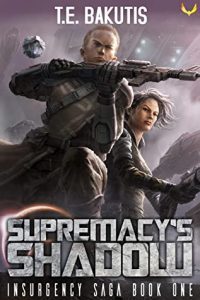 Hayden Cross has mourned his wife’s tragic death for the last thirteen years. His misuse of pills finally resulted in him losing his job as a military investigator. That is when a former ally resurfaces, promising to deliver a message from his late wife for a price. His marriage was the happiest he’d ever been, but if this message is real, something within the life they had built was a lie. To hear his wife’s voice again, all he must do is confront the most sadistic crime boss on the planet, Ceto. He may also have to save this planet from tyranny. Regrettably, the fate of humankind might just rest on Hayden’s shoulders.
Hayden Cross has mourned his wife’s tragic death for the last thirteen years. His misuse of pills finally resulted in him losing his job as a military investigator. That is when a former ally resurfaces, promising to deliver a message from his late wife for a price. His marriage was the happiest he’d ever been, but if this message is real, something within the life they had built was a lie. To hear his wife’s voice again, all he must do is confront the most sadistic crime boss on the planet, Ceto. He may also have to save this planet from tyranny. Regrettably, the fate of humankind might just rest on Hayden’s shoulders.
The Supremacy consists of an advanced stage of genetically modified humans reigning over the planets, Ceto and Phorcys. Through genetic manipulation and drugs, these humans have become far superior in intellect and strength. Their rule dictates all natural-born grovel in subservience. Unwilling to submit to the Supremacy’s oppressive rule, a ruthless group called the Patriots rebel. Hayden’s new mission wedges him right into the mix of this interplanetary war. While Supremacy’s Shadow is sarcastic and fun, this novel does grimly examine the next stage of human evolution. What will happen when science allows a select group to become genetically superior? What happens to those left behind in this advanced society?
Supremacy’s Shadow’s worldbuilding is pure delight. While Science Fiction can have a steep learning curve, T.E Bakutis slips lore and information with ease. I had the best time exploring these planets and learning their technology. I didn’t notice any info dumps and yet, this universe felt extensive. While Supremacy’s Shadow encompasses two planets, its criminal underworld was given spectacular depth. I loved the crime lords and their gangs, their double crosses and schemes, their signature torture methods.
Supremacy’s Shadow is pleasantly absurd with its satirical main character. Hayden Cross is presented as this snarky badass, but in no way does he thrive in this book. His mistakes have cost him everything before and continue to haunt him. I appreciated the fact Hayden’s mental illness maintains a constant presence throughout. As he searches for the answers behind his wife’s death, he struggles with composure and literally keeping himself together. My one critique for Supremacy’s Shadow might be he is knocked out a bit repetitively, though I also struggle to fault this. What Hayden manages to endure is astonishing. I never knew how and if he would survive.
Read Supremacy’s Shadow by T.E Bakutis
The post REVIEW: Supremacy’s Shadow by T.E Bakutis appeared first on Grimdark Magazine.
August 10, 2021
An Interview With Kevin Hearne
Today we are talking to New York Times bestselling author, Kevin Herne. Herne is the author of multiple fantasy series, The Iron Druid Chronicles, The Seven Kennings, and Ink & Sigil. He also often works in collaboration with Delilah S. Dawson for their The Tales of Pell series. Herne chats with us about the power of the written word, tyromancers, and much more.
GdM: I read that Ken Kesey’s One Flew Over the Cuckoo’s Nest was a big inspiration for you as a writer. Why is that, and how has it influenced your writing?
First, I have to acknowledge that rereading it today, there are a lot of problematic bits. But what interested me at the time I read it (in the early nineties) was the narrator’s voice and how his language changed as his mental health improved. It illustrated how vital language use is to a character’s personality, and that observation has really stuck with me and influenced how I approach building a character. What’s their vocabulary, their manner of expression, their favorite stock phrases? It signals quite a bit about who they are.
 GdM: I watched an interview where you called science fiction and fantasy’s current state a golden age. I couldn’t agree more. Who are some outstanding authors that you are following right now?
GdM: I watched an interview where you called science fiction and fantasy’s current state a golden age. I couldn’t agree more. Who are some outstanding authors that you are following right now?
Andrea Stewart! Read The Bone Shard Daughter, y’all. And The Ten Thousand Doors of January by Alix Harrow. Any or all of The Murderbot Diaries by Martha Wells.
GdM: In an interview I had read from years ago, you had mentioned reading Chew and Revival. Two great graphic novel series. As much as we live in a golden age of SFF, I think the same can be true of graphic novels and comics. Would you agree, and have you read any lately that you thought were fantastic?
I think there’s a lot of great stuff going on, absolutely. However, I confess I haven’t read many comics or graphic novels in recent years. I used to rely on recommendations from people at the comic shop, but I haven’t gone to one in, uh…eek, four years now? Excuse me, I’m just gonna go park my butt in the Oubliette of Shame and think about what I’ve done.
GdM: Chuck Wendig occasionally speaks pretty passionately on twitter about things like apples and sandwiches. What is something you are passionate about, aside from books, reading, and writing? I hear you enjoy a good whiskey sour.
Yeah, I’m into nature photography these days and share plenty of photos on my Instagram, and I follow a lot of nature accounts there. Wombats and quokkas and stuff. I also tend to share good food and drink, and I even started a hobby account called @chipstandsofcanada where I go by the name Chippy McChipface. It’s all chip stands and chip wagons, their menus, and sometimes (but not always) their food. It’s kind of a Canadian thing—in the US you have food trucks, but up here they’re all chip wagons because they always offer fries and poutine no matter what else they offer. Some of them specialize in something—grilled cheese sandwiches, chicken wings, or gourmet sausages, perhaps—but you can always get a basket of fries covered in gravy and cheese curds. I enjoy the names of these small businesses and their bright paint jobs, because the name of the game is grabbing attention. So far my favorite is a wagon named Cheesus Murphy and the Grateful Bread.
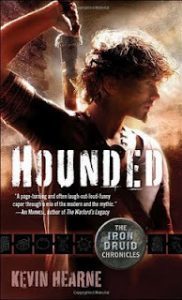 GdM: Can you tell me about tyromancers? How did you discover that was a real thing?
GdM: Can you tell me about tyromancers? How did you discover that was a real thing?
Sure! Tyromancers are folks who can detect the patterns of the future in the formation of cheese curds. Pattern recognition is the basis of many forms of seerage—whether it’s augury, reading tea leaves or palms, or tarot cards. I don’t recall exactly how I came across it, but once I did, I knew I wanted to create an anthology based on cheese wizards. It was just a mountain I needed to climb. So that’s how Three Slices came to be: I asked Chuck and Delilah to write a novella that included tyromancy, wrote one myself, and kablam: summit achieved. You can buy the world’s first tyromancy anthology in ebook or audio today, so cheez, don’t wait!
GdM: What is #shakespuck and #spicepuck? Have you thought of branching out into other things such as #bladerunnerpuck, #Labyrinthpuck, or #ROUSpuck? Because the world needs all of these.
Ha! Well, it was a way to goof around on Twitter by juxtaposing hockey with Shakespeare. I’d share screencaps of a Shakespeare movie, quoting lines or appreciating a performance as I watched it on my laptop, and interrupt it to celebrate goals of a playoff game that was broadcasting on TV. So you might see “But soft? What light through yonder breaks?” followed by “TKACHUK GOES FIVE-HOLE! YEAAAAH BABY!” I did it with several Shakespeare movies and also did a couple of Jane Austen adaptations and the David Lynch version of Dune. I could certainly do some other stuff next time hockey season rolls around.
GdM: How do you write the different voices for your story and keep them all on track? I have heard that you use Scrivener tabs. Could you explain that process? It seems like you do a ton of prep work on every character before sitting down to write because they are all so very unique.
This recalls the earlier question about Cuckoo’s Nest. I definitely think about how characters speak and how that reveals who they are. And that Scrivener tabs thing—I use that specifically for the Seven Kennings trilogy, where I’m weaving together eleven or twelve different first-person narratives and they all need to sound like people who aren’t me. Part of it is what they love and therefore what they notice. Hanima, for example, wants to lift people up, so she’s always noticing the highlights of being alive and declaring that they’re “the best.” Gondel Vedd loves language, his husband, and mustard, so he talks about these things almost to the exclusion of all else. Daryck du Löngren is a hunter so he’s constantly noticing ambient noises and his surroundings, yet he depends on others for smells since he broke his nose too many times in fights and suffered nerve damage.
Once I have an idea of who they are, it necessarily colors how they take input, process it, and deliver output. There are some subtleties of language I pay attention to as well, some dry syntax stuff that might bore people to tears if I broke it down, but which I hope pays off on the page. The tabs allow me to write all of a single character’s chapters in sequence to keep myself in that headspace, and thereby (hopefully) keep their language consistent.
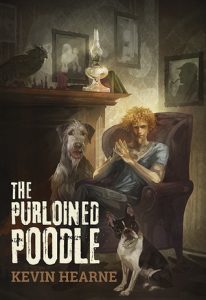 GdM: You have worked with audible hall of famer Luke Daniels on the entire Iron Druid series for audio narration. Do you adjust your storytelling for his voice, knowing that he will be recording it for a listening audience?
GdM: You have worked with audible hall of famer Luke Daniels on the entire Iron Druid series for audio narration. Do you adjust your storytelling for his voice, knowing that he will be recording it for a listening audience?
The only adjustments I make now are to insert something in there to mess with him a little bit. For example, at one point Granuaile had to run across part of Poland and had to stop somewhere for a break. I could have picked any city on the map, but I picked the one with the most consonants: Bydgoszcz. And yes, I laughed maniacally while I typed that out. Luke is simply outstanding and can handle anything.
GdM: You have a writing partner for the Kill the Farm Boy series in the great Delilah S. Dawson. What was your writing schedule like when working with a partner? Did you split up the story into specific sections or come together to write it in the same space?
Both! We would meet (in New Orleans or Seattle) to kind of sketch out characters and a broad plot outline, then we would trade writing chapters without worrying who the point-of-view character was. All characters were our characters, in other words, and none belonged to only one of us. The entire process was delightful. I’d write a chapter, email it, and work on something else until a new chapter arrived in my inbox. That chapter would make me laugh and then it was my turn again. Super fun—and, I hope, fun for readers.
GdM: Tell me about Oberon. How much fun did you have writing him? He is about the best animal character I have ever read and brings me joy just thinking about him. Was he always an Irish Wolfhound? Or was that a no-brainer due to the Irish folklore connection in Iron Druid/Ink & Sigil world?
He was always a wolfhound, yeah, because the early version of the breed—warhounds—are mentioned in the old stories about Cú Chulainn. I figured an Irish Druid would want one as a friend, especially if he himself could shapeshift into one. But Oberon’s character and behavior were modeled on a couple of smaller dogs with expressive faces, a pug and a Boston terrier who gave me much joy for many years. They unfortunately have moved on to another plane now, but I’m glad their spirit lives on in Oberon. He was (and is) an absolute blast to write.
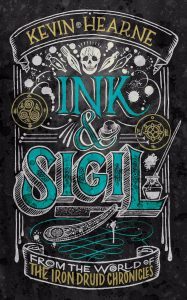 GdM: Your new series, Ink & Sigil, takes place in the same world as the Iron Druid but is very much its own thing with its own distinct voice. What made you decide to come back to this world?
GdM: Your new series, Ink & Sigil, takes place in the same world as the Iron Druid but is very much its own thing with its own distinct voice. What made you decide to come back to this world?
Well, I love the world and didn’t want to leave—it’s just that Atticus told his story the way he wanted to tell it. So a different narrator was needed, and Al MacBharrais presented himself as an interesting contrast—aging instead of eternally youthful.
GdM: Could you tell me a bit about Al MacBharrais as a character?
He’s a sixty-three-year-old sigil agent who’d like to retire but can’t because his apprentices keep dying in freak accidents. He discovers, however, that they might not be accidents after all; he’s been cursed, perhaps doubly so, and until those curses are lifted he’ll be unable to train a successor. As a sigil agent who writes and enforces contracts with otherworldly entities, using magical inks and sigils invented by Brighid, First among the Fae, he runs into many of the same deities that Atticus and Oberon did, so there’s plenty of continuity with the Iron Druid books without requiring people to have read them first. He’s been widowed for more than a decade and feels lonely, so he’s trying to do something about that, albeit slowly.
GdM: Buck Foi is a hilarious foil to Al MacBharrais. Where did you get the idea for his character? Are all hobgoblins as mischievous as he is?
Answering the second part first: Hobgoblins see themselves as fulfilling the role that court jesters used to fill in monarchies. They exist to speak truth to power and poke a needle in someone’s swelled head when it gets too big. That being said, some are far more mischievous than others and some struggle with whether they want to act as a check on power or actually overthrow it. Lots of that gets explored in the second book, Paper & Blood (more on that below).
As for the idea, I’d point to A Midsummer Night’s Dream by William Shakespeare. Robin Goodfellow (or Puck) is a hobgoblin in service to Oberon, the king of the fairies, and he tends to screw things up rather comically.
GdM: Your newest book in this series, Paper & Blood, releases this month. Could you tell us a bit about where we are in the story and what we might have in store for this book?
There are only five sigil agents in the world, and when two of them disappear in Australia, Al has to go there with Buck to discover what happened. There he teams up with Atticus, Oberon, and Starbuck, and eventually they are joined by Nadia and Gladys Who Has Seen Some Shite (Yes, that whole thing is her name). Because there’s something in the Australian bush spawning some deadly chimeras, and Al wants to know why as much as he wants to stop it. Both Atticus and Al are surprised by who’s behind it and their motivation for doing it.
GdM: Lastly, the Iron Druid was a nine-book series. Are there long-term plans for Ink & Sigil?
I know how it’s going to end, but when exactly that comes depends a bit on demand. If folks want more, I can certainly write more adventures and would be delighted to do so. But I can also wrap things up in the next book, so spreading the word about these first two and getting folks to read them now would help tremendously in ensuring more to come. So have fun and tell your friends!
Read Paper and Blood by Kevin Hearne
The post An Interview With Kevin Hearne appeared first on Grimdark Magazine.
August 9, 2021
REVIEW: For Lord and Land by Matthew Harffy
Book eight of The Bernicia Chronicles continues author Matthew Harffy’s thrilling historical fiction tale set in Anglo-Saxon Britain. For Lord and Land has Beobrand travelling south to help a friend and ending up adding to the seemingly endless tension in the north as greed and ambition threaten to tear the place apart.
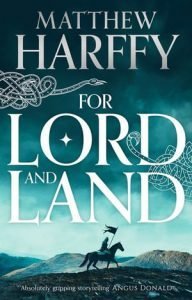 For Lord and Land may be the eighth book in the excellent series, but it is one that Harffy has written in a way that allows new readers to pick it up without any prior knowledge of the characters and not get lost. Beobrand, a Northumbrian warrior, is strong, brave, and battle-hardened. For Lord and Land finds him at an interesting point in his journey. He is not the brash, arrogant young man who would throw himself headfirst in battle without a second thought any more. He is more reflective and displays the wisdom gained through years of battle. Caught in his oath to his lord and regretting the fractured relationship with his kin, he seems weary and tired of the constant fighting. Nevertheless, he still fights with skill and passion though he watches the younger warriors around him and thinks on how much he has changed since he was in their position and whether he has gained anything from all the blood he has spilled. Harffy uses the young, eager warrior Cuthbert to show the change in Beobrand. Cuthbert longs for battle and a chance to prove himself but Beobrand urges caution and his experienced Black Shields agree that only a fool rushes into battle.
For Lord and Land may be the eighth book in the excellent series, but it is one that Harffy has written in a way that allows new readers to pick it up without any prior knowledge of the characters and not get lost. Beobrand, a Northumbrian warrior, is strong, brave, and battle-hardened. For Lord and Land finds him at an interesting point in his journey. He is not the brash, arrogant young man who would throw himself headfirst in battle without a second thought any more. He is more reflective and displays the wisdom gained through years of battle. Caught in his oath to his lord and regretting the fractured relationship with his kin, he seems weary and tired of the constant fighting. Nevertheless, he still fights with skill and passion though he watches the younger warriors around him and thinks on how much he has changed since he was in their position and whether he has gained anything from all the blood he has spilled. Harffy uses the young, eager warrior Cuthbert to show the change in Beobrand. Cuthbert longs for battle and a chance to prove himself but Beobrand urges caution and his experienced Black Shields agree that only a fool rushes into battle.
As Beobrand is caught up in the battle in the north between greedy, ambitious kings, his trusted warrior, Cynan, makes a bold decision to help a woman from his past. Risking his own life along with a handful of allies, Cynan rides towards danger and away from his responsibilities, knowing that he is risking the wrath of his lord, Beobrand. The two main plotlines deal with the theme of doing what is right. Though oaths have been given, is it right to follow men blindly when doing so will bring about pain and suffering for others? For Lord and Land follows characters burdened by such questions and shows the often harsh and brutal fallout of the decisions they make.
For Lord and Land is yet another fast-paced and bloody historical epic from Matthew Harffy. Readers both old and new will enjoy the brutal battles and interesting characters dealing with the difficult choices faced when leading others whilst listening to their own lords. For those who enjoyed Harffy’s similarly excellent A Time for Swords or Bernard Cornwell’s The Last Kingdom, this book is a must-have. Friend becomes foe. Kin fights kin. Northumbria is torn apart. Soaked in blood and with betrayal around the turn of every page, For Lord and Land is Matthew Harffy at his best.
Read For Lord and Land by Matthew Harffy
The post REVIEW: For Lord and Land by Matthew Harffy appeared first on Grimdark Magazine.
August 8, 2021
REVIEW: Dreadnoughts by Michael Carroll, John Higgins and Jake Lynch
Dreadnoughts written by Michael Carroll and illustrated by John Higgins and Jake Lynch, is a comic strip initially published in 2000 AD and Judge Dredd Magazine, now collected into a paperback. As the name doesn’t quite suggest, it is a spin-off from Judge Dredd – but is distinct from the other dozen series set in Dredd’s universe by nature of being several decades before the birth of Joseph Dredd, in the infancy of the authoritarian Judge system. This is an expansion of material found in the now-classic 2006 Judge Dredd series Origins, by John Wagner and the late Carlos Ezquerra, and is accompanied by a series of prose novellas simply titled Judges.
 Carroll in Dreadnoughts is not writing, therefore, of Mega-City One in the year 2099, but of Boulder, Colorado in the year 2035. The difference is not simply a matter of toning down the classic judge uniform and removing the golden eagle shoulder pads – though Higgins does a good job following the early Judge designs from Origins, placing them in a restrained and relatively realistic palate – no mega-blocks or neon for Boulder.
Carroll in Dreadnoughts is not writing, therefore, of Mega-City One in the year 2099, but of Boulder, Colorado in the year 2035. The difference is not simply a matter of toning down the classic judge uniform and removing the golden eagle shoulder pads – though Higgins does a good job following the early Judge designs from Origins, placing them in a restrained and relatively realistic palate – no mega-blocks or neon for Boulder.
The newly-minted Judges we follow in Dreadnoughts, therefore, are struggling with a police force and a population unused to (resistant, even) the Judge system. It might be the law, but there’s plenty that don’t much care for it or its consequences. That our protagonist, Judge Glover enters Boulder by breaking up a protest with lethal force will tell you quite how popular she is likely to become. Glover is an prototypical Dredd – harsh and unlikeable, tempered by competence and an utterly unwavering willingness to enforce the law, no matter the criminal. This said, she’s less faceless than Dredd, and has a slowly unfurling backstory that makes the idea of Judges more interesting than a first glance might reveal.
This isn’t to say Dreadnoughts is utterly unlike Judge Dredd. While Dreadnoughts is less of a straightforward procedural as some Dredd storylines can be, the core of the plot involves the pursuit of a kidnapper in politically fraught circumstances. Other details, such as the unusually articulate protesters being thrown into the van post state-sponsored tutelary dentistry are right out of early Judge Dredd. There’s a few elements to the plot that reference contemporary events to some degree – but this is by no means new (compare the portrayals of President Booth in 2006’s Origins and 2017’s The Fall of Deadworld, for instance).
Dreadnoughts suffers a little from being a prequel. Its proximity to the present day makes the reader ask himself how the dickens the United States goes from what we read in the broadsheets to managing to pass such sweeping constitutional changes with bipartisan support. The sketches in Origins don’t quite suffice. But, as Carroll rightly observes in the introduction, Dreadnoughts may be best regarded as a horror story, and asking what chemicals Dr Jekyll has in his dispensary or how many hitpoints Cthulhu has are pointless endeavours.
Patches of thinness aside, Dreadnoughts is an intriguing and harrowing read, and merits three stars at the very least.
Read Dreadnoughts by Michael Carroll, John Higgins and Jake Lynch
The post REVIEW: Dreadnoughts by Michael Carroll, John Higgins and Jake Lynch appeared first on Grimdark Magazine.



